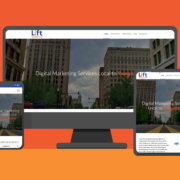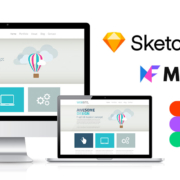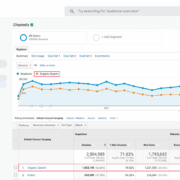6 Tips for Top-Tier Website Design
A well-designed website is essential for any company or person trying to have a significant online presence in today’s digital world. Your professional website’s design is a crucial tool in your digital marketing arsenal.
A great website acts as a digital showroom, spreading the message of your company and luring customers to learn more. If you want to wow your digital guests, follow the top six website design tips included below.
These will guarantee a user-friendly and jaw-dropping website by improving the user experience, boosting conversions, and making a lasting impression on your audience by putting these methods into practice.
1. A Business Website Needs Clear Purpose and Call to Action
It’s critical to establish your website’s objectives in detail before beginning the design process. Are you creating a community, disseminating information, or selling goods through ecommerce?
Knowing your objectives will help you design your website appropriately. Your design components, content, navigation, and functionality should all be customized to your target audience’s needs.
Knowing your purpose also helps you develop a clear call to action. Good web design should be leading your target audience towards the action you want them to take, not just on your homepage, but on every page. Make sure that you know what purpose each page is serving, and what call to action should be included.
A Tip for Beginners (or Seasoned Marketers)
Keep in mind that a website with a clear purpose and focus will likely engage more visitors and increase conversions. Also, make sure that your other digital marketing branches are consistent with your website, including your social media accounts.
2. Don’t Skimp On White Space and Subheadings
The simplicity of a website’s design is one of its main tenets. A cluttered or perplexing design may turn visitors away. Strive for a simple, user-friendly layout that makes it easy for visitors to move throughout your website.
To direct visitors to the desired locations, use clear headlines, logical menu structures, and noticeable call-to-action (CTA) buttons. Always keep in mind that a simple design improves usability and inspires consumers to explore more. Don’t be afraid of white space on your website. Allow your content to breathe from one web page to the next. The look and feel of your site should be inviting.
3.Pick Simple Fonts and Color Palettes
Your homepage should get your main message across right away. Through simple color schemes, typography, and other page elements, your website visitors should have a great user experience while taking in your brand identity.
To reemphasize, the navigation, functionality, and user experience of your website are critical to your visitors remaining on your website to find what they are looking for. To create the best user experience – sometimes less design is more. Background colors and font colors shouldn’t contrast, typography should be easy to read. Basically, if it hurts the eyes – you probably need to switch it up.
Remember – bad user experience can also hurt your SEO efforts, so if keeping your customer’s eyes from bleeding isn’t motivation enough – do it for your own good!
4. Optimize for Mobile Devices
Making your website mobile-friendly is now essential in a world that is becoming more and more mobile-driven. Responsive web design for mobile devices is essential since a sizable percentage of internet traffic now comes from smartphones and tablets.
Make sure your website adjusts to various screen sizes and resolutions without any noticeable lag. Reduce load times and simplify navigation to ensure a seamless user experience on all devices. Your search engine rankings will increase thanks to mobile optimization, which also increases customer satisfaction. Website builders such as WordPress, Wix, SquareSpace, or Weebly will have templates for automatic mobile optimization.
5. Use High-Quality Visuals and Animations
In order to properly engage your audience and communicate your brand’s message, visual elements are crucial. Include top-notch pictures, videos, and graphics that are consistent with your company’s identity. Stock photos are easily available, but you want to avoid a generic feeling as much as possible.
The visuals should be improved for quick loading without sacrificing quality. Visuals that are strategically placed can break up text, offer visual appeal, and improve audience engagement. Use informative alt tags and file names when optimizing photos for search engines.
Keep Great Designs in Mind
Also, always stay up-to-date on the latest design trends, and don’t be afraid of a potential redesign down the road. If it means a more responsive web design that could lend itself to better search engine optimization, it is likely worth a redesign.
6. Prioritize Website Speed
Users need fast load times in the hectic digital world of today. Not only that – quick page load times are also important for ranking high on search engines.
Websites that load slowly may frustrate users and cause them to leave. Reduce the use of big files and pointless plugins to increase the speed of your website. Choose a reputable site hosting company, enable browser caching, choose a simple design template, and compress photos without sacrificing quality.
Make the required adjustments to your website to ensure a seamless browsing and readability experience for your visitors. From your headers to your landing pages, ensuring that your design elements do not disrupt the user experience or pull your visitors’ attention where it shouldn’t be, such as on the speed at which design elements of your website load, is a crucial part of website design. Periodically evaluate your website’s speed using tools like Google PageSpeed Insights or GTmetrix.
Take Your Web Design to the Next Level
In order to produce a compelling and user-friendly experience, it is important to carefully examine a variety of factors while designing an effective website. You may design a website that captivates your audience and accomplishes your objectives by defining its purpose, streamlining navigation, optimizing for mobile devices, utilizing high-quality visuals throughout your visual hierarchy, and placing a priority on website speed.
These website design tips can make your homepage a powerful tool for increasing brand recognition, drawing in visitors, and boosting conversion rates, in addition to being aesthetically pleasing. It’ll take time and patience, but the payoff will be there once you see your beautifully designed website for the first time!
Are you a web design beginner and still want the most out of your website? Give the professionals a call! We can handle everything from website design to social media management, search engine optimization, and more.












